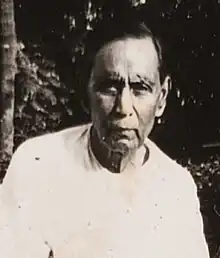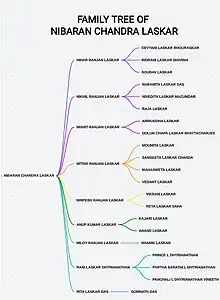Nibaran Chandra Laskar | |
|---|---|
 Prof. Nibaran Chandra Laskar | |
| Member of Parliament, Lok Sabha | |
| In office 1952–1962 | |
| Constituency | Cachar, Assam |
| Constituency | Cachar, Assam |
| Member of Constituent Assembly of India | |
| In office 9 December 1946 – 24 January 1950 | |
| Personal details | |
| Born | 14 January 1902 Niz Phulbari, Assam, British India |
| Died | 25 June 1987 (aged 85) Silchar |
| Political party | Indian National Congress |
| Spouse | Krishna Kumari Devi (m. 1921) |
| Children | Nihar Ranjan Laskar, Nikhil Ranjan Laskar, Rani Laskar, Nishit Ranjan Laskar, Nitish Ranjan Laskar, Nripesh Ranjan Laskar, Anup Kumar Laskar, Rita Laskar, Niloy Ranjan Laskar
GRAND CHILDRENS: Devyani Laskar Bhouraskar, Indrani Laskar Sharma, Sourav Laskar. Nabanita Laskar Das, Nivedita Laskar Mazumdar, Raja Laskar. Aniruddha Laskar, Dolon Chapa Laskar Bhattacharjee. Moumita Laskar, Sangeeta Laskar Chanda, Mahasweta Laskar, Vedant Laskar. Vikram Laskar, Reya Laskar Saha. Kajari Laskar, Anand Laskar. Shamik Laskar. Prince L Dhyrianathan, Partha Sarathi L Dhyrianathan, Panchali L Dhyrianathan Vineeth. Somnath Das. |
| Residence(s) | Phulbari, Shillongpatty, Silchar, Assam |
| Alma mater | MC College, Dhaka University (MA) |

Nibaran Chandra Laskar (14 January 1902 – 25 June 1987)[1] was an Indian politician belonging to the Indian National Congress. He was elected to the Lok Sabha lower house of the Parliament of India from the Cachar, Assam in 1952 and 1957. Laskar was also a member of the Constituent Assembly of India.[2][3][4]
Early life and background
Nibaran Chandra Laskar was born on 14 January 1902. He was a singer, musician, sportsman, social worker and educationist. He was a gold medalist and double MA in Sanskrit and Bengali from Dhaka University. He was a founder professor of Guru Charan College, the first college of Cachar district in the state of Assam. He was the founder Principle of Cachar college. Laskar moved into full term politics in 1944.
In the year 1961, he resigned from active politics following a protest against Assam Assembly's decision to make Assamese the state language of Assam considering the fact that Bengali was also a prominent language of the state and 90% of the population of Barak Valley were Bengali speaking. On 13 May 1961, 11 protesters were killed by police firing at a peaceful protest event at Silchar Railway Station. Several MPs and MLAs resigned from their posts after that incident and Laskar was one of them. He was engaged in social service and philanthropy in later part of his life.
He was a Member of Silchar Local Board, Silchar Municipal Board, 1946–49; President of Cachar Kalyan Samiti, 1946–48; General Secretary of Samaj Sanjivani Samiti, Cachar; Member of All India Cottage Industries Board, 1949–52; Member of F.A.O., 1950–52, Deputy Minister of Relief and Rehabilitation, Assam Government, 1951–52; Member of Rehabilitation Finance Administration, 1956–57; Member of Assam Legislative Assembly 1947–52; Member of Constituent Assembly of India, 1947–50; Member of First Lok Sabha, 1952–57; Member of Public Accounts Committee, 1955–57.[5]
Nibaran Chandra Laskar was also involved in the retention of Cachar (Silchar) & other parts of Barak Valley in India and prevented it from merging with Pakistan (east) during partition. "Azadi Ka Amrit Mahotsav" archives & repository (celebrating 75 years of India's independence) has documented this contribution of Nibaran Chandra Laskar.https://cmsadmin.amritmahotsav.nic.in/district-reopsitory-detail.htm?2730
Family Tree, depicting 3 generations, of Prof. Nibaran Chandra Laskar.https://commons.wikimedia.org/wiki/File:Family_Tree_Nibaran_Chandra_Laskar.jpg
References
- ↑ Nikhil Ranjan Laskar. (2019). Memoirs of life. Vicky publishers.
- ↑ Rāmacandra Kshīrasāgara (1994). Dalit Movement in India and Its Leaders, 1857-1956. M.D. Publications Pvt. Ltd. pp. 257–. ISBN 978-81-85880-43-3. Retrieved 5 March 2019.
- ↑ India. Parliament. Lok Sabha (2003). Indian Parliamentary Companion: Who's who of Members of Lok Sabha. Lok Sabha Secretariat. p. 272. Retrieved 24 December 2020.
- ↑ Ramesh Chandra (2003). Dalit Identity in the New Millennium: Dalit leaders. Commonwealth Publishers. p. 126. ISBN 978-81-7169-765-6. Retrieved 24 December 2020.
- ↑ parliament. second lok sabha bio profile.